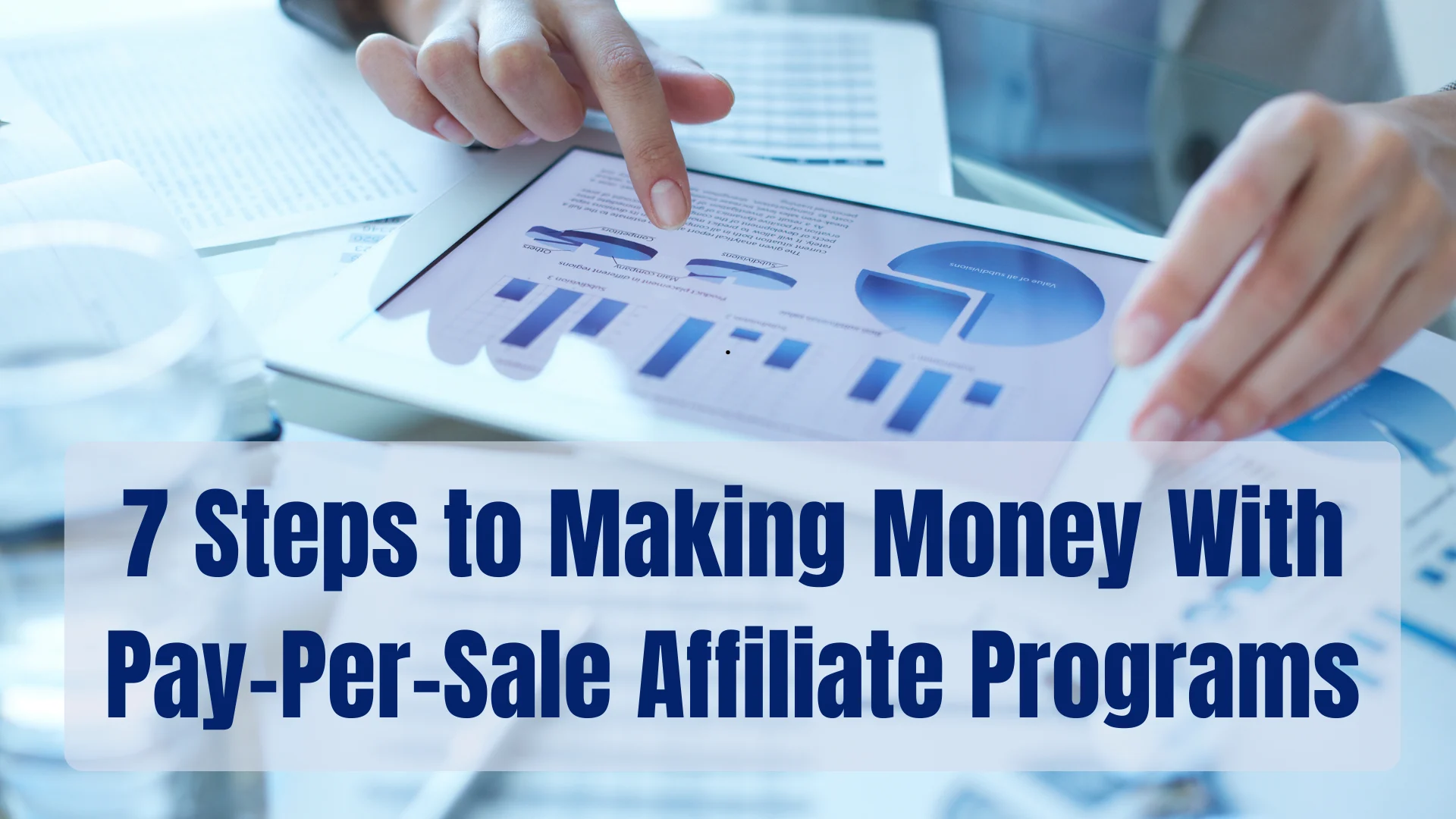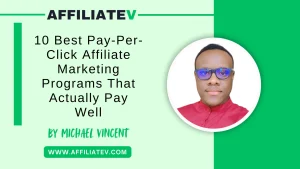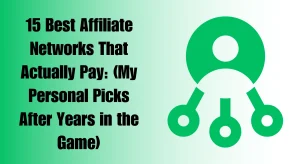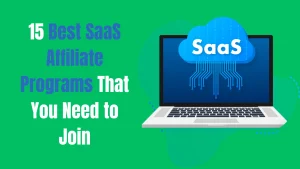7 Simple Steps to Making Money With Pay-Per-Sale Affiliate Programs

Have you ever heard about people making good money online just by running a blog or a small website? Honestly, it used to sound a bit unbelievable to me: Like one of those “sounds great, but not realistic” things. But then I stumbled upon Pay-Per-Sale affiliate programs, and I realized they’re legit.
It’s pretty straightforward: you share a product, and if someone buys it through your link, you get paid a commission. No hidden tricks, just a simple system that works.
When I first got into it, I was totally lost. I had no idea where to start, and the thought of promoting products online felt a little overwhelming. But once I figured it out, it was like a lightbulb moment. Turns out, it’s not as complicated as it seems.
Now, I want to share what I’ve learned so you can skip the confusion and get straight to the good part. Let’s break it down so you can start earning without all the trial-and-error I went through.
IMPORTANT: If you’re diving into pay-per-sale affiliate programs, Amazon Associates Affiliate Program is my favorite book for getting a solid grip on how affiliate marketing works. It’s filled with actionable strategies that can help you earn commissions, especially with programs like Amazon’s, which work on a pay-per-sale basis. From choosing the right products to mastering the art of promotion, this book covers it all.
Key Takeaways
- Understanding Pay-Per-Sale affiliate programs can unlock substantial income opportunities.
- Focus on creating quality content to increase conversion rates and audience trust.
- Performance-based commissions only reward affiliates for completed sales, emphasizing the importance of strategic marketing efforts.
- Regularly engaging your audience through social media can lead to better conversion outcomes.
- Staying informed and adaptable is crucial as affiliate marketing continues to evolve.
Introduction to Affiliate Marketing
Affiliate marketing is all about earning money by promoting other people’s products or services. With options like pay-per-sale or pay-per-lead, it’s super flexible and easy to scale as you grow.
If you’re someone looking to make money online, it’s a great fit. Affiliate networks even help connect you with businesses so you can find the right products to promote without all the hassle.
And the earning potential? It’s big. Some programs pay anywhere from $100 to over $7,000 per sale. For example, Semrush offers $200 for new subscriptions, and Shopify gives up to $150 per referral. With commissions often between 10% and 50%, many marketers make an average of $82,000 a year.
The key is putting in the effort, choosing the right programs, and building connections in the industry. It’s not just about the money but creating a sustainable income and growing your network over time.
Understanding Pay-Per-Sale Affiliate Programs
So, pay-per-sale affiliate programs, here’s the deal. You get paid when someone buys something through your unique affiliate link. No purchase, no payout. For businesses, it’s a no-brainer. They only spend money when they see results. And for affiliates like you and me, the commissions can be really sweet if you know how to work it.
Fun fact: by 2028, affiliate marketing in the U.S. alone is expected to hit $15.8 billion. Wild, right? It shows just how big a deal this whole thing is, especially in spaces like e-commerce and digital products.
But listen, it’s not all rainbows and easy money. To make sales, you’ve got to get people’s attention and win their trust. That means creating content that feels real and relatable because no one likes being sold to.
The good news is some programs offer flat fees or percentage-based commissions, and the high-ticket ones can pay serious money. Plus, a lot of these programs now have two-tier setups. So not only do you earn from your sales, but also from people you bring into the program. It’s kind of like building your own little network.
If you take the time to understand how it all works and play your cards right, you could seriously grow your income. It’s not magic, but it’s pretty close.
Advantages of Pay-Per-Sale Affiliate Programs
Pay-per-sale affiliate programs offer big benefits for both affiliates and merchants. Affiliates can earn up to 30% of each sale they make. This means they get paid based on their success, pushing them to work harder.
Merchants benefit by spending less on marketing. They only pay for actual sales, cutting down on waste. This makes marketing more efficient and effective.
Starting as an affiliate is often free, making it easy for new people to join. Affiliates can pick products that fit their audience, helping them succeed.
The following table highlights the key advantages of pay-per-sale programs:
| Advantage | Description |
|---|---|
| High Earning Potential | Affiliates can earn 5% to 30% commission on sales, increasing their income willingness to promote effectively. |
| Lower Risk for Merchants | Advertisers only pay for sales, minimizing expenses linked to ineffective marketing campaigns. |
| Performance-Based Earning | Affiliates’ income reflects their sales success, fostering competition and motivation. |
| Low Startup Costs | Becoming an affiliate entails minimal to no costs, lowering barriers for entry into the industry. |
But, there are challenges too. New affiliates must learn sales skills and build an online presence. This helps them turn visitors into customers. Thinking about these points helps decide if pay-per-sale programs are right for you.
Steps to Making Money With Pay-Per-Sale Affiliate Programs
Success with pay-per-sale affiliate programs isn’t about luck, it’s about taking the right steps. Focusing on strategies that have been tried and tested, you can grow your earnings and build a steady, reliable income over time.
Let’s break it done in a simple. actionable steps to help you get started and make the most of these programs.
1. Building a Strong Online Presence

Having a strong online presence is everything when it comes to affiliate marketing. It’s not just about being visible; it’s about showing people that you know your stuff and they can trust you.
When you create content, whether it’s a blog post, a video, or even a quick story on social media it’s your chance to prove you’re the real deal. People want to buy from someone who feels authentic, not some random name on the internet.
If you want your presence to stand out, here’s what works: mix it up. Use platforms that make sense for you and your audience. Maybe you’re great at writing, so blogging is your thing. Or maybe you’re more comfortable on camera, so YouTube or TikTok could be your sweet spot. The trick is to keep showing up consistently. Not in an “everyday grind” kind of way, but enough so people know you’re serious.
And when you create content, make it good. A single thoughtful piece that connects with people will always be better than ten posts that feel rushed. Oh, and don’t just talk to people, talk with them. Answer questions, reply to comments, and show you’re a real person.
The cool thing is, as you grow your presence, everything else gets easier. People trust you, they engage more, and eventually, they buy. Building that reputation as an expert in your space might take time, but it’s one of those things where the effort pays off in ways you didn’t even expect.e presence, you set yourself up for lasting success in affiliate marketing.
2. Selecting the Right Products to Promote
Picking products that match your audience’s needs is key in affiliate marketing. When you promote the right products, you build trust and meet your audience’s expectations. Knowing your niche helps find products that solve real problems. This leads to better engagement and more sales.
Using data can improve your product choice. For example, different sectors offer different commission rates. eCommerce programs usually give 1-20% commission, while freelance services can offer 25-70% for the first order.
Affiliate programs have different cookie lifetimes and payout structures. Amazon, for instance, has a 24-hour cookie but pays for any purchase in 90 days. Knowing this helps you match your promotions with your audience’s buying habits.
When choosing products, trust is crucial. Endorse products you believe in or have used. This approach not only promotes relevant products but also reassures your audience. By focusing on clear solutions, you boost engagement and revenue.
For instance:
| Industry | Commission Rate | Cookie Life | Minimum Payout |
|---|---|---|---|
| eCommerce | 1-20% | 24 hours | $10 |
| Freelancing | 25-70% | 30 days | $100 |
| Web Hosting | 40% | 30 days | $100 |
| Amazon Associates | Varies | 24 hours | $10 |
In short, choosing the right affiliate products means they meet your audience’s needs. This approach leads to a more informed and effective promotional strategy.
3. Effective Promotion Strategies
To excel in promoting affiliate products, it’s crucial to implement effective promotion strategies that resonate with your audience.
Consider leveraging content creation, such as in-depth product reviews or comparisons, to engage potential customers effectively. This approach nurtures audience engagement and fosters trust, increasing the likelihood of driving sales.
Personalization is a key driver in maximizing conversions. For instance, companies that utilize segmented email lists report improved conversion rates by 66%. Also, 75% of consumers prefer personalized marketing communications, showing the power of tailored content strategies.
- Showcase the benefits and real-life applications of the products you promote.
- Engage your audience through interactive means, such as polls or live sessions, which can enhance retention by 60%.
- Develop a unique promotional style that aligns with your target audience’s preferences and behaviors.
- Implement strong calls to action (CTAs) to lead user behavior effectively, significantly impacting conversion rates.
The impact of affiliate marketing is substantial, as it contributes between 5% and 25% of major brands’ total internet sales. Companies tapping into email databases averaging over 450 million contacts can significantly enhance their campaign’s reach.
Marketers who focus on driving sales through consistent updates and engaging content tailored to their audience will see improved performance.
Regular maintenance of older content ensures relevance while employing long-tail keywords can enhance conversion due to lower competition. Ultimately, the journey toward effective promotion remains a blend of strategy, creativity, and adaptation to audience needs.
4. Creating High-Quality Content
Creating high-quality content is key to a successful affiliate marketing strategy. Content like tutorials, guides, and reviews helps build trust with your audience. It makes you an expert in your field and brings more sales opportunities.
In today’s world, knowing how to create great content is crucial. By 2022, 83% of digital nomads were their own bosses, showing the demand for quality online content. This means we need to make content that speaks to a wide range of people.
High-ticket affiliate marketing offers big commissions, from 10% to 30%. For example, HubSpot’s program gives affiliates a 30% recurring commission. This encourages engaging content that attracts consistent visitors.
To make your content better, try these tips:
- Deeply research your niche to find topics your audience cares about.
- Use SEO to make your content more visible and attract more visitors.
- Make your content look good with high-quality images and videos.
- Interact with your audience to improve your content.
- Use analytics to see what content works best.
Keeping your content high-quality keeps your audience interested and builds trust. As affiliates, we must always look for new ways to keep our content successful and grow our audience.
5. Importance of SEO for Affiliate Marketing

For affiliate marketers, understanding SEO is key to boosting organic traffic. SEO helps drive traffic and build trust with your audience. Did know that 78.3% of affiliate marketers use SEO as a primary traffic source? Using good SEO can make your affiliate links more visible and effective.
SEO tactics like keyword research and optimizing content are vital. They help you rank higher on search engines. Since 51% of shoppers start their search on Google, SEO is crucial. It helps affiliates reach more people, as organic traffic often leads to more sales.
Choosing the right keywords is important. Targeting words like “review” or “best product” can attract buyers. Research shows that moving up in search rankings can double your clicks, boosting sales.
Therefore, always work on improving your site’s SEO as it can pay off big time. With affiliate marketing spending expected to rise over time, SEO is key. Start working on your SEO now to reach more people with your valuable content and offers.
6. Transparency and Trust with Your Audience
Being open about affiliate marketing is key to gaining your audience’s trust. It’s not just about following the law; it also makes you more believable. This authenticity can win over potential customers.
Include an affiliate disclaimer page on your website or in your content. For example, here is my affiliate disclosure.
When you share your affiliate ties, people see your advice as real. Top affiliate marketers make $100,000 to $150,000 a year. This shows that being honest can lead to big earnings.
Your marketing should be built on honest reviews from your own experience. For example, if you’ve tried the Invideo AI program, you can share how they offer 25% and 50% commissions on their various subscription plans.
This gives your audience a real look at how affiliate programs operate and shows them the kind of earnings they might expect. People trust your genuine take on things, so don’t hold back from sharing what you’ve learned.
- Share detailed information about how commissions work.
- Declare your affiliate partnerships clearly in your content.
- Explain your product selection process to foster confidence.
Telling real stories about your experiences and wins can boost your sales. The $8.2 billion affiliate marketing industry shows the power of trust-based strategies.
Being transparent in affiliate marketing can build a loyal fan base. Always be honest about your affiliate links to keep a strong bond with your viewers.
7. Leveraging Social Media and Email Marketing
Social media marketing is now a key tool for promoting affiliate products. It accounts for over 30% of all affiliate marketing traffic. Influencers are crucial in creating content that matches your brand, helping engage your audience. You can increase visibility and guide traffic to your affiliate links by making targeted posts and using stories.
Email marketing is also vital for connecting with your audience. It has an open rate of 21.5% and a click-through rate of 2.5%, showing its power in nurturing leads. Sending personalized emails can share special offers, making people more likely to buy.
- Find your target audience on social media to make sure your content hits the mark.
- Use metrics to see how well your social media and email campaigns are doing, then tweak them if needed.
- Get your audience involved with interactive content, encouraging them to share and check out your affiliate links.
Each platform reaches different people; TikTok is great for trendy items for younger folks, while LinkedIn is better for B2B stuff. Knowing this helps you tailor your strategies for promoting affiliate products.
In the end, combining social media marketing with email marketing can greatly boost your ability to connect with your audience. This leads to better affiliate marketing results.
Common Mistakes to Avoid in Affiliate Marketing
Affiliate marketing can be very profitable, but it comes with its own set of challenges. Knowing the common mistakes is key to success. One big mistake is promoting products that don’t fit your audience.
Studies show that up to 30% of marketers promote products they haven’t tried themselves. This can damage your relationship with your audience.
Another mistake is not being open about your affiliate relationships. Not disclosing this can hurt your audience’s trust.
About 68% of marketers don’t focus on product quality, which can upset customers. This lowers your conversion rates and overall satisfaction.
Only 40% of new affiliates do enough keyword research. Bad SEO can limit your visibility and sales. Knowing that affiliate marketing has an average conversion rate of 1% to 5% shows how competitive it is.
Not tracking important metrics can make it hard to see how well your strategies are working. About 50% of affiliates don’t check key metrics like click-through rates and conversions.
Ignoring the terms and conditions of programs can lead to losing commissions or even having your account shut down. Around 70% of marketers don’t read these terms.
Not checking your affiliates’ links regularly can hurt your audience engagement and potential earnings. About 45% of marketers don’t do this.
Summary:
| Mistake | Impact | Percentage of Marketers Affected |
|---|---|---|
| Promoting Irrelevant Products | Strained audience relationships | 30% |
| Neglecting Product Quality | Decreased customer satisfaction | 68% |
| Poor Keyword Research | Limited visibility and sales | 40% |
| Not Measuring KPIs | Difficult campaign assessment | 50% |
| Ignoring Program Terms | Potential commission loss | 70% |
| Neglecting Link Reviews | Drop in engagement | 45% |
Knowing these mistakes and avoiding them can greatly improve your success in affiliate marketing. This can lead to a more stable income over time.
Pay-Per-Sale Affiliate Programs: Case Study Example
Let’s dive into a case study of TIWIB, an affiliate site that makes over $20,000 a month. This is 66% of its total income. With over 2,800,000 visitors and a big social media following, TIWIB shows how good strategies can bring in big money.
This case study shows three important strategies used by top affiliate marketers:
- Transparency with Audience: Being open about affiliate partnerships builds trust.
- Valuable Content Creation: TIWIB made over 100,000 words in 80-100 posts.
- Product Selection Focus: Picking products that match the audience is key, with an average sale price of over $100.
Looking at affiliate performance, we see different partners bring in different amounts. For example, Affiliate partner A made 14 times more than partner B, even though B sent only a third as much traffic. This shows how picking the right affiliates is crucial in Pay-Per-Sale programs.
You can see great results in your affiliate marketing by using these strategies. Learning from this case study, you can achieve success in Pay-Per-Sale programs with the right approach.
Conclusion
Alright, so now you’ve got the 7 steps to making money with pay-per-sale affiliate programs. I get it. It might feel a little overwhelming at first. But trust me, once you start taking action and finding your rhythm, it becomes second nature. The process isn’t about rushing to make a sale, it’s about building trust with your audience and being consistent.
When I first dipped my toes into affiliate marketing, I’ll be honest, I was skeptical. I thought, “Will this even work?” But after sticking with it and focusing on the right steps, I started seeing small wins that snowballed into something bigger. It wasn’t a get-rich-quick thing as those don’t exist but when you put in the work and follow the right strategies, it pays off.
What I love about affiliate marketing is how much room there is to grow as you build relationships with your audience. It’s not just about selling stuff but about offering value and solving problems for people.
The thing is, this is a business model that evolves with you. As the digital space keeps changing, you’ve got to adapt too. As long as you stay focused on helping your audience and providing good content, the money will follow.
The journey is worth it, so go ahead, and take the leap. It might feel intimidating at first, but once you start, you’ll see it’s not as hard as it seems. Trust me, you got this.
Frequently Asked Question
What are pay-per-sale affiliate programs?
Pay-per-sale affiliate programs are partnerships where you earn a commission whenever someone makes a purchase through your unique affiliate link. This is a performance-based model, meaning you only earn when the sale happens.
How do I get started with pay-per-sale affiliate programs?
To get started, you’ll want to choose a niche that interests you, sign up with an affiliate network, and start promoting products. Building an online presence through blogs, social media, or videos will help attract your audience and drive sales.
Do I need a website to make money with pay-per-sale programs?
While having a website or blog isn’t mandatory, it can greatly help. It gives you a platform to create valuable content and promote affiliate products more effectively. You can also use social media channels or YouTube to reach your audience.
How do I choose the right products to promote?
Focus on products that are relevant to your audience’s interests and needs. It’s also helpful to choose products that you believe in and have used yourself. When you’re authentic and honest in your recommendations, it builds trust with your audience.
How long does it take to start earning with pay-per-sale affiliate programs?
The timeline can vary. Some affiliates start seeing sales within a few weeks, while others might take a few months to build momentum. It depends on how much effort you put into creating content, engaging your audience, and marketing the products.
What are the potential earnings from pay-per-sale affiliate programs?
Earnings vary depending on the products you promote, the commission rate, and how well you market them. Some programs offer small commissions (like 5-10%), while others, like high-ticket items, can offer hundreds or even thousands of dollars per sale.







Thanks for sharing. I read many of your blog posts, cool, your blog is very good.